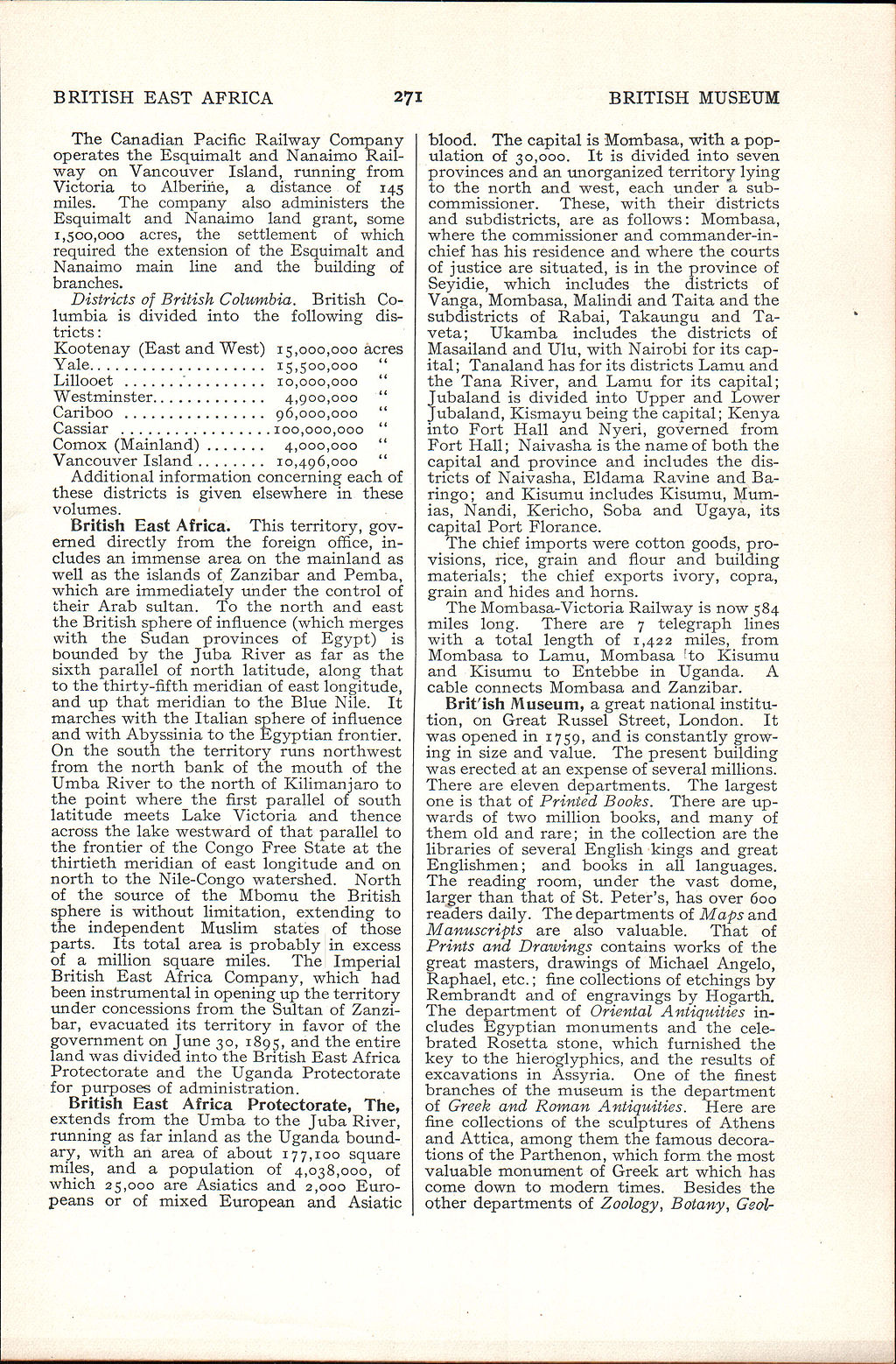BRITISH EAST AFRICA
271
BRITISH MUSEUM
The Canadian Pacific Railway Company operates the Esquimalt and Nanaimo Railway on Vancouver Island, running from Victoria to Alberiiie, a distance of 145 miles. The company also administers the Esquimalt and Nanaimo land grant, some 1,500,000 acres, the settlement of which required the extension of the Esquimalt and Nanaimo main line and the building of branches.
Districts of British Columbia. British Columbia is divided into the following districts : Kootenay (East and West) 15,000,000 acres
Yale.................... 15,500,000
Lillooet................ 10,000,000
Westminster............. 4,900,000
Cariboo ................ 96,000,000
Cassiar .................100,000,000
Comox (Mainland)....... 4,000,000
Vancouver Island........ 10,496,000
Additional information concerning each of these districts is given elsewhere in these volumes.
British East Africa. This territory, governed directly from the foreign office, includes an immense area on the mainland as well as the islands of Zanzibar and Pemba, which are immediately under the control of their Arab sultan. To the north and east the British sphere of influence (which merges with the Sudan provinces of Egypt) is bounded by the Juba River as far as the sixth parallel of north latitude, along that to the thirty-fifth meridian of east longitude, and up that meridian to the Blue Nile. It marches with the Italian sphere of influence and with Abyssinia to the Egyptian frontier. On the south the territory runs northwest from the north bank of the mouth of the Umba River to the north of Kilimanjaro to the point where the first parallel of south latitude meets Lake Victoria and thence across the lake westward of that parallel to the frontier of the Congo Free State at the thirtieth meridian of east longitude and on north to the Nile-Congo watershed. North of the source of the Mbomu the British sphere is without limitation, extending to the independent Muslim states of those parts. Its total area is probably in excess of a million square miles. The Imperial British East Africa Company, which had been instrumental in opening up the territory under concessions from the Sultan of Zanzibar, evacuated its territory in favor of the government on June 30, 1895, and the entire land was divided into the British East Africa Protectorate and the Uganda Protectorate for purposes of administration.
British East Africa Protectorate, The, extends from the Umba to the Juba River, running as far inland as the Uganda boundary, with an area of about 177,100 square miles, and a population of 4,038,000, of which 25,000 are Asiatics and 2,000 Europeans or of mixed European and Asiatic
blood. The capital is Mombasa, with a population of 30,000. It is divided into seven provinces and an unorganized territory lying to the north and west, each under a sub-commissioner. These, with their districts and subdistricts, are as follows: Mombasa, where the commissioner and commander-in-chief has his residence and where the courts of justice are situated, is in the province of Seyidie, which includes the districts of Vanga, Mombasa, Malindi and Taita and the subdistricts of Rabai, Takaungu and Ta-veta; Ukamba includes the districts of Masailand and Ulu, with Nairobi for its capital ; Tanaland has for its districts Lamu and the Tana River, and Lamu for its capital; Jubaland is divided into Upper and Lower Jubaland, Kismayu being the capital; Kenya into Fort Hall and Nyeri, governed from Fort Hall; Naivasha is the name of both the capital and province and includes the districts of Naivasha, Eldama Ravine and Ba-ringo; and Kisumu includes Kisumu, Mum-ias, Nandi, Kericho, Soba and Ugaya, its capital Port Florance.
The chief imports were cotton goods, provisions, rice, grain and flour and building materials; the chief exports ivory, copra, grain and hides and horns.
The Mombasa-Victoria Railway is now 584 miles long. There are 7 telegraph lines with a total length of 1,422 miles, from Mombasa to Lamu, Mombasa ^to Kisumu and Kisumu to Entebbe in Uganda. A cable connects Mombasa and Zanzibar.
Brit'ish Museum, a great national institution, on Great Russel Street, London. It was opened in 1759, and is constantly growing in size and value. The present building was erected at an expense of several millions. There are eleven departments. The largest one is that of Printed Books. There are upwards of two million books, and many of them old and rare; in the collection are the libraries of several English kings and great Englishmen; and books in all languages. The reading room, under the vast dome, larger than that of St. Peter's, has over 600 readers daily. The departments of Maps and Manuscripts are also valuable. That of Prints and Drawings contains works of the great masters, drawings of Michael Angelo, Raphael, etc.; fine collections of etchings by Rembrandt and of engravings by Hogarth. The department of Oriental Antiquities includes Egyptian monuments and the celebrated Rosetta stone, which furnished the key to the hieroglyphics, and the results of excavations in Assyria. One of the finest branches of the museum is the department of Greek and Roman Antiquities. Here are fine collections of the sculptures of Athens and Attica, among them the famous decorations of the Parthenon, which form the most valuable monument of Greek art which has come down to modern times. Besides the other departments of Zoology, Botany, Geol-
